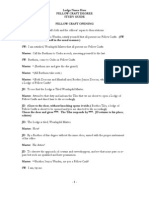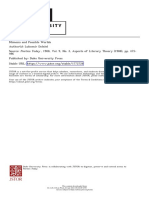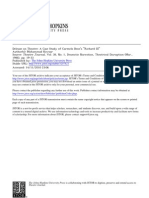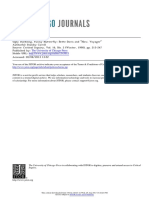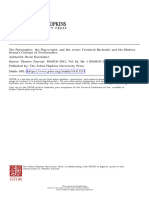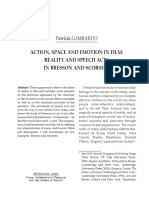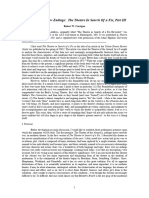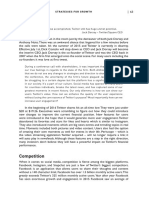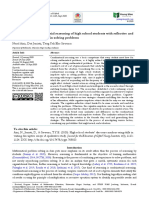Annotated Bibliography
Uploaded by
api-114449221Annotated Bibliography
Uploaded by
api-114449221Annotated Bibliography Beckett, Samuel. Waiting for Godot. New York: Grove Press, 1994. Print.
This is the play by Samuel Beckett that will be one of my two main play texts. I will use Waiting for Godot, along with Old Times, to develop an argument about the way that Beckett and Pinter use stage directions in these two plays. I will do this by pulling examples from the text and analyzing them. I will look for both consistencies and trends within the text and between the two plays. I will also use textual examples to supplement the arguments of other scholarly work that I will incorporate into my paper. Cima, Gay Gibson. Performing Women. N.p.: Cornell University Press, 1994. Print. In this piece, Cima makes arguments about how Pinter stages his plays and uses different lenses through which the audience can view the play and the characters can view each other. More relevantly to this paper, she makes arguments about physical presence and the effects of movement, using textual evidence and her own analysis of that evidence. I will use her arguments and textual examples to support my own arguments. With a different approach to the same topic, Cima will alter my argument slightly while still reinforcing my basic claims. Also, some of her arguments mesh nicely with those of Esslin and Skloot. Esslin, Martin. Absurd Drama. N.p.: Penguin Books, 1965. Print. In the Introduction to his book Absurd Drama, Esslin introduces the concept of the Theatre of the Absurd and surveys the playwrights that he considers part of this Theatre. Specifically, he discusses the way that Beckett and Pinter use a variety of methods to express complex images, which he calls poetic. Among these methods, he discusses the use of stage directions and movement, saying that the playwrights use movement to contribute to the formation of these images. I will use this source to complement the arguments I am making, as well as draw the link between Beckett and Pinter. The arguments made in this source go well with those made in Cima, and will help particularly to support my arguments about Beckett. Also, Esslins arguments will help to counter those made by Kern. Kern, Edith. Drama Stripped for Inaction: Becketts Godot. Yale French Studies, No. 14, Motley: Todays French Theatre (1954): 41-47. Web. 2 Dec. 2011. This source discusses the action and meaning, or lack thereof, in Waiting for Godot. Kern argues that the detached, distant nature of action and movement in the play robs it of meaning. I will use this argument as a bit of a counter-point or departure from the arguments I make in the paper. Instead of emphasizing meaning, as I will argue, Kern says that stage directions deprive it of meaning, and all of the movement becomes irrelevant. As a result, Kern says, the relationships between the characters become irrelevant as well. She cites several textual examples tangentially, but I will delve more deeply into a textual example to illustrate her arguments and show their validity. Her arguments represent a departure from the other arguments in my paper. Her argument is just a different interpretation of the same general effect that I am identifying, that these playwrights use stage directions to cause movement, which has some effect on the
meaning or emotion in the play. I will counter her argument somewhat, offering insight of my own as well as textual evidence to back it up. Pinter, Harold. Old Times. New York: Grove Press, 1971. Print. This is the play by Harold Pinter that will be one of my two main play texts. I will use Old Times, like Waiting for Godot, to form my arguments about the way that the two playwrights use stage directions. I will do this by pulling examples from the text and analyzing them. I will look for both consistencies and trends within the text and between the two plays. I will also use textual examples to supplement the arguments of other scholarly work that I will incorporate into my paper. Skloot, Robert. "Putting Out The Light: Staging The Theme Of Pinter's Old Times." Quarterly Journal Of Speech 61.3 (1975): 265-270. Communication & Mass Media Complete. Web. 1 Dec. 2011. This source talks about the role of light and staging in Old Times. Though it focuses mostly on the use of lighting in the stage directions, it also discusses the use of stage directions in directing movement. Skloot argues that the role of this movement is to emphasize the existential issues raised in the play, and show that the characters are stuck in a perpetual struggle. I will use this argument to tie the two plays together, as there is evidence of this in both plays. This source has an interesting take on the use of stage directions, and one that complements the other arguments of the paper well. I will use it to further develop my own arguments, particularly those about the relationships of the characters in Old Times.
Works Cited Beckett, Samuel. Waiting for Godot. New York: Grove Press, 1994. Print. Cima, Gay Gibson. Performing Women. N.p.: Cornell University Press, 1994. Print. Esslin, Martin. Absurd Drama. N.p.: Penguin Books, 1965. Print. Kern, Edith. Drama Stripped for Inaction: Becketts Godot. Yale French Studies, No. 14, Motley: Todays French Theatre (1954): 41-47. Web. 2 Dec. 2011. Pinter, Harold. Old Times. New York: Grove Press, 1971. Print. Skloot, Robert. "Putting Out The Light: Staging The Theme Of Pinter's Old Times." Quarterly Journal Of Speech 61.3 (1975): 265-270. Communication & Mass Media Complete. Web. 1 Dec. 2011.
You might also like
- Get (Etextbook PDF) For Carpentryu00a03rd Canadian Edition Byu00a0floyd Vogt Free All Chapters100% (6)Get (Etextbook PDF) For Carpentryu00a03rd Canadian Edition Byu00a0floyd Vogt Free All Chapters53 pages
- (PDF) Download Monster Girl Encyclopedia Vol. 2 by - Kenkou Cross Full Pages30% (10)(PDF) Download Monster Girl Encyclopedia Vol. 2 by - Kenkou Cross Full Pages2 pages
- Merry Christmas Mr. Lawrence Guitar Tab by Mark Magdamo100% (1)Merry Christmas Mr. Lawrence Guitar Tab by Mark Magdamo3 pages
- Websites To Download Free Audio Books - Best Of: Kay Tan Web 2.067% (3)Websites To Download Free Audio Books - Best Of: Kay Tan Web 2.022 pages
- Sheqxel Workplace Inspection Dashboard TemplateNo ratings yetSheqxel Workplace Inspection Dashboard Template28 pages
- Ben Winters - The Non-Diegetic Fallacy - Film, Music, and NarrativeNo ratings yetBen Winters - The Non-Diegetic Fallacy - Film, Music, and Narrative40 pages
- Lubomír Doležel - Mimesis and Possible Worlds100% (1)Lubomír Doležel - Mimesis and Possible Worlds23 pages
- The Philippines, A Singular and A Plural Place PDFNo ratings yetThe Philippines, A Singular and A Plural Place PDF184 pages
- A Gestalt Therapy Approach To Shame and Self100% (4)A Gestalt Therapy Approach To Shame and Self20 pages
- Characteristics of The Theatre of The AbsurdNo ratings yetCharacteristics of The Theatre of The Absurd9 pages
- Metatheatre in Aeschylus' Oresteia: by Robert Lewis SmithNo ratings yetMetatheatre in Aeschylus' Oresteia: by Robert Lewis Smith11 pages
- Szmekova Gabriela BachelorDipThesis Understanding S. Beckett S Act Without Words INo ratings yetSzmekova Gabriela BachelorDipThesis Understanding S. Beckett S Act Without Words I46 pages
- Shattering Hamlet S Mirror Theatre and R PDFNo ratings yetShattering Hamlet S Mirror Theatre and R PDF3 pages
- Ffeminist and Queer Performance - Critical StrategiesNo ratings yetFfeminist and Queer Performance - Critical Strategies3 pages
- Deleuze On Theatre A Case Study of Carmelo Bene S Richard III100% (2)Deleuze On Theatre A Case Study of Carmelo Bene S Richard III16 pages
- Differential-Surface: Deleuze and Superhero Comics Joshua M. HallNo ratings yetDifferential-Surface: Deleuze and Superhero Comics Joshua M. Hall13 pages
- Staging Social and Political Spaces: Living Theatre in Joyce's "The Dead"No ratings yetStaging Social and Political Spaces: Living Theatre in Joyce's "The Dead"10 pages
- University of Illinois Press The Journal of Aesthetic EducationNo ratings yetUniversity of Illinois Press The Journal of Aesthetic Education12 pages
- Garner All Theateris RevolutionaryreviewNo ratings yetGarner All Theateris Revolutionaryreview5 pages
- Reinelt, Janelle - The Politics of Discourse - Performativity Meets TheatricalityNo ratings yetReinelt, Janelle - The Politics of Discourse - Performativity Meets Theatricality16 pages
- Monologue Theatre, Solo Performance - Clare Wallace - IntroduçãoNo ratings yetMonologue Theatre, Solo Performance - Clare Wallace - Introdução16 pages
- Usan Glaspell and The Anxiety of Expression: Language and Isolation in The Plays.No ratings yetUsan Glaspell and The Anxiety of Expression: Language and Isolation in The Plays.5 pages
- Anthony-Dramaturgical Approach To Comics Character (2023)No ratings yetAnthony-Dramaturgical Approach To Comics Character (2023)18 pages
- A Post-Feminist and Evolutionist Reading of A Dolls HouseNo ratings yetA Post-Feminist and Evolutionist Reading of A Dolls House20 pages
- Stanley Cavell - Bette Davis and Now VoyagerNo ratings yetStanley Cavell - Bette Davis and Now Voyager36 pages
- Aesthetics and Poetics of The Novel in Viet Thanh Nguyens The SyNo ratings yetAesthetics and Poetics of The Novel in Viet Thanh Nguyens The Sy90 pages
- Henrik Ibsen and Conspiracy Thinking - The Case of Peer GyntNo ratings yetHenrik Ibsen and Conspiracy Thinking - The Case of Peer Gynt36 pages
- Kornhaber PhilosopherPlaywrightActor 2012No ratings yetKornhaber PhilosopherPlaywrightActor 201217 pages
- Action, Space and Emotion in Film: Reality and Speech Acts in Bresson and ScorseseNo ratings yetAction, Space and Emotion in Film: Reality and Speech Acts in Bresson and Scorsese19 pages
- Doleel Lubomir 1988 Mimesis and Possible Worlds Poetics Today 9 3 Aspects of Literary Theory 1988 PP 475 496No ratings yetDoleel Lubomir 1988 Mimesis and Possible Worlds Poetics Today 9 3 Aspects of Literary Theory 1988 PP 475 49623 pages
- Vector Theory and the Plot Structures of Literature and DramaFrom EverandVector Theory and the Plot Structures of Literature and DramaNo ratings yet
- The scope of naturalism in british Working DramaNo ratings yetThe scope of naturalism in british Working Drama402 pages
- The Search For New Endings-The Theatre in Search of A Fix, Part IIINo ratings yetThe Search For New Endings-The Theatre in Search of A Fix, Part III8 pages
- 1998 - Christopher J Lee - TheDifferentialRoleofRidiculeinSarcasmandIronyretrieved-2014!10!15No ratings yet1998 - Christopher J Lee - TheDifferentialRoleofRidiculeinSarcasmandIronyretrieved-2014!10!1516 pages
- Febriyanti Lihawa. 2014. Nim: 321 408 020. "Figure of Speech Analysis in William Shakespeare's Poem"No ratings yetFebriyanti Lihawa. 2014. Nim: 321 408 020. "Figure of Speech Analysis in William Shakespeare's Poem"15 pages
- Dayacap - Book Review - Phenomenology For ActorsNo ratings yetDayacap - Book Review - Phenomenology For Actors6 pages
- Marina Berzins McCoy - Image and Argument in Plato's Republic-State University of New York Press (2020)No ratings yetMarina Berzins McCoy - Image and Argument in Plato's Republic-State University of New York Press (2020)366 pages
- Elizabethan Dramatic Conventions and Elizabethan RealityNo ratings yetElizabethan Dramatic Conventions and Elizabethan Reality24 pages
- Underground Railway Theater, Engine of Delight & Social Change: Third Edition 2023From EverandUnderground Railway Theater, Engine of Delight & Social Change: Third Edition 2023No ratings yet
- Washington, The Writings of George Washington, Vol. IX (1780-1782) (1891)No ratings yetWashington, The Writings of George Washington, Vol. IX (1780-1782) (1891)400 pages
- Scalia & Garner - A Note On The Use of Dictionaries100% (1)Scalia & Garner - A Note On The Use of Dictionaries10 pages
- THE DERIVATION OF MASONIC SYMBOLISM AND MOZARTS USE OF IT IN Magic Flute100% (1)THE DERIVATION OF MASONIC SYMBOLISM AND MOZARTS USE OF IT IN Magic Flute60 pages
- Module 2 - Handout 2.0 - Demand Theory, Analysis and EstimationNo ratings yetModule 2 - Handout 2.0 - Demand Theory, Analysis and Estimation4 pages
- Sample Weber Health Assessment Nursing 7th100% (1)Sample Weber Health Assessment Nursing 7th30 pages
- 48.lamp Illumination Control System Using Sensor CircuitNo ratings yet48.lamp Illumination Control System Using Sensor Circuit4 pages
- St. Bernard Parish Gov't v. United States, No. 05-1119L (Fed. Cl. May 1, 2015)100% (1)St. Bernard Parish Gov't v. United States, No. 05-1119L (Fed. Cl. May 1, 2015)74 pages
- To Change The Overall Look of Your DocumentNo ratings yetTo Change The Overall Look of Your Document2 pages
- PCB (Printed Circuit Board) Layout and EMI (Electromagnetic I..100% (3)PCB (Printed Circuit Board) Layout and EMI (Electromagnetic I..2 pages
- Mechanical Liquid Flow Switch: Penn Commercial RefrigerationNo ratings yetMechanical Liquid Flow Switch: Penn Commercial Refrigeration2 pages
- TFN Transes - HX of NRG To NRG TheoristNo ratings yetTFN Transes - HX of NRG To NRG Theorist14 pages
- GR 9 Final Assessment Datesheet and SyllabusNo ratings yetGR 9 Final Assessment Datesheet and Syllabus7 pages
- Since 1989 Da Milano Is An Integral Leather Brand That Manufactures and Retails High End Leather Bags and Accessories For Both Men and Women100% (1)Since 1989 Da Milano Is An Integral Leather Brand That Manufactures and Retails High End Leather Bags and Accessories For Both Men and Women21 pages
- Adi Shankara Got Into An Argument With A Man and WonNo ratings yetAdi Shankara Got Into An Argument With A Man and Won2 pages





